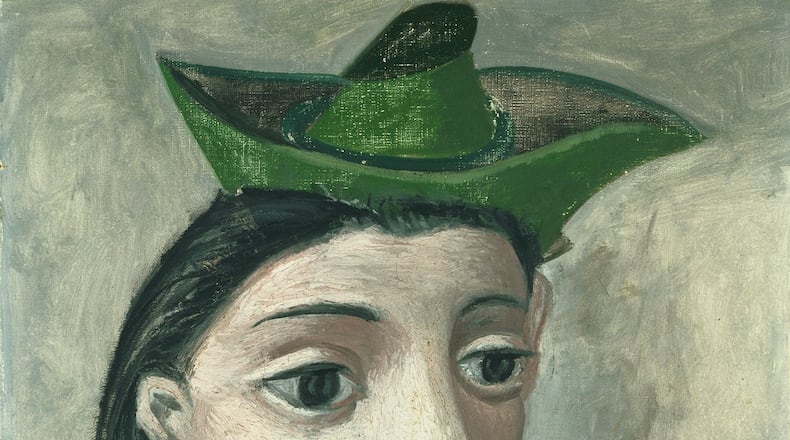Established in 1921 as the first American museum of modern art, Washington, D.C.’s Phillips Collection was the incubator and showplace for collector Duncan Phillips’ unique approach to art. In a telling essay from the exhibition catalogue, critic Robert Hughes explains how Phillips, a member of the WASP establishment, was shocked while a student at Yale in the 1900s, by his wealthy contemporaries’ ignorance about art. Phillips’ collection was driven by his personal taste and interests, but also by a desire, forged in that real-world experience, to educate. “European Masterworks: The Phillips Collection” at the High Museum is an attempt to convey Phillips’ unique approach to art in an assemblage of work spanning from the 18th to 20th centuries.
“European Masterworks” is certainly a show that parades a festival of riches before you—Picassos, Braques, van Goghs, Miros. But not at the expense of insight. Sometimes when presented with a blockbuster exhibition of great works, a certain fatigue can set in, as we’re asked to reflexively genuflect before an assemblage of greatness. But “European Masterworks” generates enlightenment rather than simply awe. It’s a thoughtful show that invites viewers to look past the blinding light of “greatness” to see what was truly radical, new and interesting with each passing innovation and variation, primarily in painting, though a small selection of bronze sculptures are also on display, offering similar revelations. Not every work will knock your socks off. But the juxtapositions will.
Timelines can be enormously instructive in art, but the juxtapositions in Duncan Phillips’ wide-ranging collection of “European Masterworks” turn out to be the source of some deeply satisfying epiphanies here. “Contrast and analogy” were more Phillips’ speed. And so Kandinsky rubs up against Degas who rubs up against Klee and Miro and Rousseau and you find yourself transported into the quintessence of paint and painting, experiencing an intense appreciation for art history’s constantly bold shifts in color, line, subject, perspective. Surveying a host of schools: Impressionism, Post-Impressionism, Expressionism, Cubism, one understands their comparable shock and novelty, overturning and remaking the world anew. In some instances, certain themes are grouped together only to emphasize radical differences in style as in a collection of still life paintings. A circa 1728 Jean-Baptiste-Siméon Chardin is placed near an 1893 Paul Cezanne followed by a poetic, nearly abstract 1953 Giorgio Morandi “Still Life” that looks like a sleek Fiat next to the luscious, decadent sedans of previous eras.
“European Masterworks” is also a show that reminds you of the sheer wonder of paint as an infinitely morphing, malleable medium. Focused so insistently on painting through the ages, “Masterworks” alerts you to its alchemic magic. On one hand, there are Jean-Baptiste-Camille Corot’s velvety, luminous brushstrokes, capable of a nearly photographic realism in his landscape “Genzano.” And then there are the violent slashes of paint in Chaim Soutine’s “Return from School After the Storm” which transform a pastoral idyll of two children walking on a country lane into an emotional wallop of historical anxiety. It’s only in seeing van Gogh next to a Courbet or a Monet that allows you to truly appreciate van Gogh’s pulsating, breathing paint, those feverish teals and mustards and a funhouse perspective that draws you into a work like “Entrance to the Public Gardens at Arles,” urging you undeniably down the artist’s path and into his psychological craw.
Phillips was not only a passionate, knowledgeable collector, but wall text attests to his critical eye and shrewd observations about art. Rather than someone who merely needed to possess these masterworks, he longed to delve into the sublime mystery of painting. He was an advocate and maybe occasionally a zealot who believed that Braque was the better artist than Picasso. By the final room of the show, a painterly face-off between Braque and Picasso, you’re even inclined to believe him.
ART REVIEW
“European Masterworks: The Phillips Collection”
Through July 14. 10 a.m.-5 p.m. Tuesdays-Thursdays and Saturdays; 10 a.m.-9 p.m. Fridays; noon-5 p.m. Sundays. $14.50, ages 6 and above; free for children 5 and younger and members. High Museum of Art, 1280 Peachtree St. NE, Atlanta. 404-733-4444, www.high.org
Bottom line: Epiphanies abound in a meaty show that reintroduces viewers to the power of paint and innovation in European modernism.
About the Author
The Latest
Featured

